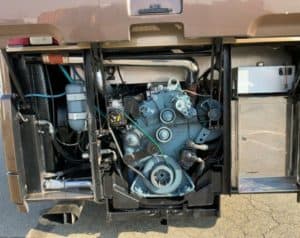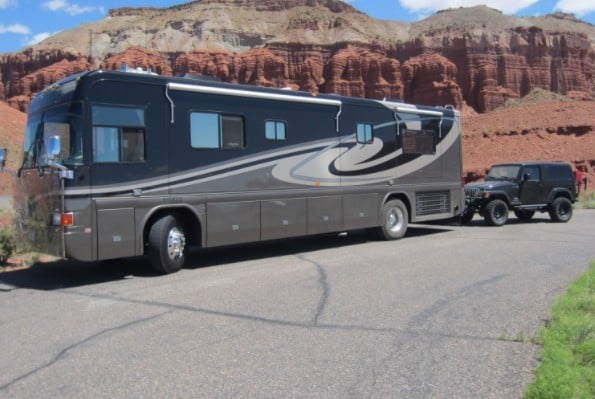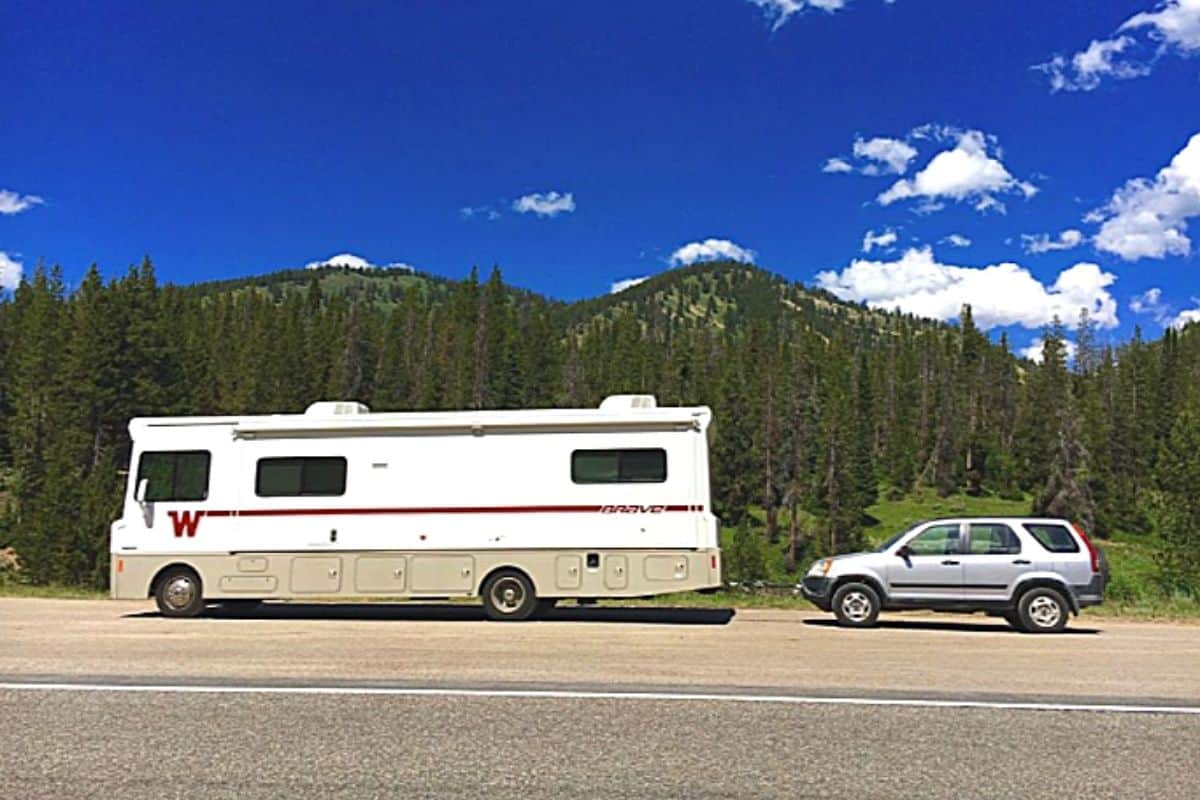Class A motorhomes are one of the largest RVs on the road, with typical lengths ranging from 30 to 40 feet and gross vehicles weights of often more than 15,000 pounds.
But if you’re thinking about towing a car behind a Class A motorhome or “toad”, as it is often referred to, you might be wondering how much a Class A motorhome can tow?
Class A motorhomes have the highest towing capacity of all the motorhome classes, ranging from 5,000 pounds on the smallest and cheapest models to as much as 20,000 pounds on the largest and most expensive models.
However, most Class A motorhomes will typically have a towing capacity between 5,000 and 10,000 pounds.
If you’re looking for more specific information on how much a Class A RV can tow though, you definitely want to keep reading.
As we provide 15 examples of Class A motorhome towing capacities.
As well as explain what affects the towing capacity of a Class A motorhome, explain the different weights and limits associated with a Class A RV, and provide specific examples of what a Class A motorhome can tow.
15 Class A Motorhome Towing Capacities (Lowest to Highest)
| Model | Length | GCWR | Towing Capacity |
| Jayco Alante 26X | 28′ 5″ | 23,000 lbs. | 5,000 lbs. |
| Winnebago Vista 29V | 30′ | 23,000 lbs. | 5,000 lbs. |
| Forest River FR3 | 31′ 8″ | 23,000 lbs. | 5,000 lbs. |
| Winnebago Sunstar 35U | 35′ | 23,000 lbs. | 5,000 lbs. |
| Fleetwood Flair 28A | 29′ 3″ | 21,000 lbs. | 8,000 lbs. |
| Thor Axis 25.6 | 26′ 9″ | 22,000 lbs. | 8,000 lbs. |
| Thor Motor Coach A.C.E. 29.2 | 28′ 10″ | 23,000 lbs. | 8,000 lbs. |
| Coachmen Mirada 32LS | 34′ 10″ | 26,000 lbs. | 8,000 lbs. |
| Thor Motor Coach Palazzo 33.6 | 34′ 11″ | 30,000 lbs. | 10,000 lbs. |
| Holiday Rambler Navigator 37R | 38′ 9″ | 33,000 lbs. | 10,000 lbs. |
| Fleetwood Discovery 40M | 40′ 1″ | 46,400 lbs. | 10,000 lbs. |
| Tiffin Phaeton 37BH | 38′ 7″ | 48,320 lbs. | 10,000 lbs. |
| Thor Motor Coach Tuscany 40RT | 41′ 1″ | 48,600 lbs. | 15,000 lbs. |
| Forest River Berkshire XLT 45A | 44′ 10″ | 62,000 lbs. | 15,000 lbs. |
| American Coach Eagle 45K | 44′ 11″ | 66,000 lbs. | 20,000 lbs. |
What Affects the Towing Capacity of a Class A Motorhome?
There are four main items that affect the towing capacity of a Class A motorhome both directly and indirectly.
Which includes the amount of cargo you load into the motorhome, the type of engine the motorhome has, the overall size of the motorhome, and the gross combined weight rating of the motorhome.
The Amount of Cargo Loaded into the Motorhome
When towing with a Class A motorhome, it’s important to keep in mind that RV manufacturers calculate the max towing capacity of a motorhome assuming that the motorhome is minimally loaded with gear and cargo.
So if you fully load the Class A motorhome to its max occupant and cargo carrying capacity with passengers, provisions, and cargo, you should reduce the amount of weight you’re towing with the motorhome.
Because when you’re towing with a motorhome, you have to perform a bit of a balancing act, in order to keep the weight below both the gross vehicle weight rating and the gross combined vehicle weight rating.
By reducing the weight in one area to offset the added weight in another.
Type of Engine
 The type of engine a Class A motorhome has can have a big impact on the towing capacity of the RV.
The type of engine a Class A motorhome has can have a big impact on the towing capacity of the RV.
As motorhomes with diesel engines tend to have more towing capacity compared to motorhomes with gasoline engines, due to the fact that diesel engines typically offer more power and torque compared to gasoline engines.
This means a diesel pusher (type of Class A motorhome where the engine is in the rear), will generally have more towing capacity compared to a Class A motorhome with a gasoline engine.
Overall Size of the Motorhome
Generally, larger and heavier Class A motorhomes will have higher towing capacities compared to smaller and lighter Class A motorhomes.
This is because larger and heavier Class A RVs, will generally have much larger engines that produce more power, as well as more robust suspensions, axles, and frames to handle the larger and heavier load, which helps to increase the max towing capacity of the motorhome.
Gross Combined Weight Rating
The last item that can have a big impact on the towing capacity of a Class A motorhome is its gross combined weight rating.
As the gross combined weight rating of a Class A RV indicates the maximum allowable total weight of not only the fully-loaded motorhome but also the fully loaded trailer the motorhome is towing.
This means that motorhomes with a higher gross combined weight rating will typically have a higher towing capacity as well, as there is more total maximum weight to work with.
Different Class A Motorhome Weights and Limits
If you’re new to the RV world it’s easy to get confused when it comes to Class A motorhome weight.
As there are actually 7 different types of weight that can be used to describe the weights around a Class A motorhome including curb weight, occupant cargo-carrying capacity, towing capacity, tongue weight rating, gross vehicle weight rating, gross axle weight rating, and gross combined weight rating.
Curb Weight
The first and most simple weight to understand on a Class A motorhome is the curb weight of the RV.
The curb weight of a Class A motorhome is the weight of the RV before anything is loaded into the RV, with the exception of a full tank of gas.
This means the curb weight of an RV does not include any weight that might be added to the motorhome from cargo, water, sewer, propane, or passengers.
Oftentimes unloaded vehicle weight (UVW) is used interchangeably with curb weight but this is technically not accurate.
Because while they are very similar, unloaded vehicle weight also takes into account the weight of a full propane tank as well.
Occupant Cargo Carrying Capacity (OCCC)
Occupant cargo carrying capacity is the max amount of weight you can load into an RV for items such as passengers, camping gear, provisions, and water, which is determined by subtracting the unloaded vehicle weight by the gross vehicle weight rating of the motorhome.
Towing Capacity
Towing capacity indicates the highest possible weight of a fully-loaded trailer or “toad” that a Class A motorhome can tow assuming a minimally loaded RV.
Tongue Weight Rating
Tongue weight is the maximum amount of downward pressure the motorhome can handle on its hitch from the tongue of the trailer or vehicle being towed.
And this is a weight that is just as important to pay attention to as the towing capacity of the motorhome.
Because exceeding the recommended maximum tongue weight of a Class A motorhome and overloading the hitch can damage the drivetrain, suspension, and even the frame, leading to very costly and expensive repairs.
So it’s important to choose a trailer that does not exceed the gross vehicle weight rating or rear gross vehicle axle weight rating of the motorhome.
Gross Vehicle Weight Rating (GVWR)
Gross vehicle weight rating is the maximum allowable weight of a fully-loaded motorhome set by the manufacturer, which indicates how much total weight the motorhome can safely handle.
The gross vehicle weight rating is one of the most common weights associated with a Class A motorhome, as all RV manufacturers highlight this weight while listing the specs of their motorhomes.
Gross Axle Weight Rating (GAWR)
Motorhomes will always have two gross axle weight ratings, including one for the front and one for the rear axle of the motorhome, which indicates the maximum amount of weight each axle can handle.
On a motorhome, the rear gross axle weight rating will always be higher than the front gross axle weight rating to accommodate for the hitch weight, when towing a vehicle with the motorhome.
Gross Combination Weight Rating (GCWR)
When towing with your Class A motorhome the gross combination weight rating of the RV is one of the most important weights to pay attention to.
As the gross combination weight rating of a motorhome indicates the maximum allowable weight of the fully-loaded motorhome as well as the fully loaded trailer or “toad” the motorhome is towing.
This weight is important because it tells you the maximum amount of total weight the RV can safely handle and encompasses all the previous weight ratings including the OCCC, GVWR, and Towing Capacity.

Can a Class A Motorhome Tow a Car?
Due to the high towing capacity of Class A motorhome, which often ranges from 5,000 to 10,000 pounds, all Class A motorhomes have the ability to tow a car or small SUV.
However, that doesn’t mean that every Class A motorhome can tow every type of passenger vehicle.
As there are many heavier SUVs and trucks that would exceed some of the lower towing capacities on a Class A RV.
So to give you a better idea of what type of vehicle a Class A motorhome can comfortably tow, we compiled the below list of vehicles that just about any Class A RV can tow including those with lower 5,000 pound towing capacities.
Vehicles a Class A Motorhome Can Tow
- Jeep Wrangler – Curb Weight 3,948 to 4,449 Pounds
- Honda CR-V – Curb Weight 3,337 to 3,569 Pounds
- Kia Sorento – Curb Weight 3,794 to 4,120 Pounds
- Ford Ranger – Curb Weight 3,992 to 4,441 Pounds
- Toyota Camry – Curb Weight 3,310 to 3,595 Pounds
- Honda Accord – Curb Weight 3,150 to 3,430 Pounds
- Chevrolet Equinox – Curb Weight 3,272 to 3,512 Pounds
- GMC Terrain – Curb Weight 3,449 to 3,659 Pounds
- Nissan Altima – Curb Weight 3,208 to 3,461 Pounds
- Ford Edge – Curb Weight 3,794 to 4,120 Pounds
Different Terms Used to Describe Motorhome Towing
There are two main terms used to describe motorhome towing, which include dingy towing and “toad” towing.
Dingy Towing
Dingy towing is the general term used to describe towing a vehicle behind an RV using either a tow bar or a tow dolly.
Toad Towing
“Toad” is a slang term used in the RV world to describe a towed automobile.
And “toad” towing most often refers to a motorhome towing a vehicle using a tow bar in order to tow a vehicle with all four wheels down.
Other terms used to describe “toad” towing also include four-down towing and flat towing.
The advantage of “toad” towing is that it places very little tongue weight or load onto the motorhome hitch.
Which helps to not exceed the gross vehicle weight rating or rear gross axle weight rating of the motorhome.
However, if you plan to use this type of towing, you need to check the vehicle’s owner manual first, as not all vehicles can be flat towed on all four wheels.
Should You Use a Weight Distribution Hitch When Towing with a Motorhome?
While towing with a weight-distribution or load leveling hitch is common practice and highly recommended when towing a travel trailer with a passenger vehicle such as SUV or truck, this is not the case when towing with a motorhome.
As you should never use a weight-distribution or load leveling hitch when towing with a motorhome.
As a weight-distribution hitch is not capable of distributing or transferring any useful amount of weight from the rear axle to the front axle of the motorhome or limiting up and down hitch movement.
And by using one, you could actually end up damaging the hitch, receiver, motorhome frame, or trailer frame.
Want to know if it’s hard to drive a Class A motorhome? If so, check out our article “Is It Hard to Drive a Class A RV? What You Need to Know“.
Recent Posts
When cruising down the highway in your RV, the last thing you want is a tire blowout! Not only is it dangerous, but RV tire replacement isn't cheap, costing $200 to $300 per tire. The good news,...
Nothing ruins an RV adventure faster than a breakdown with no way to fix it. Because of this, every RVer should have a well-stocked RV tool kit for those unexpected roadside emergencies and campsite...

